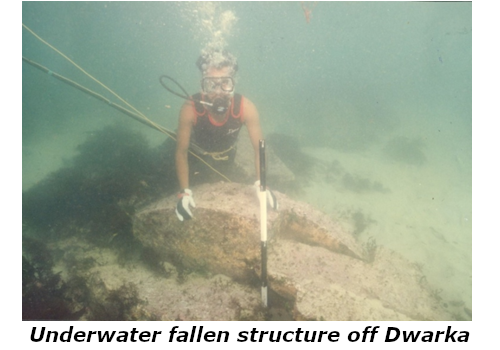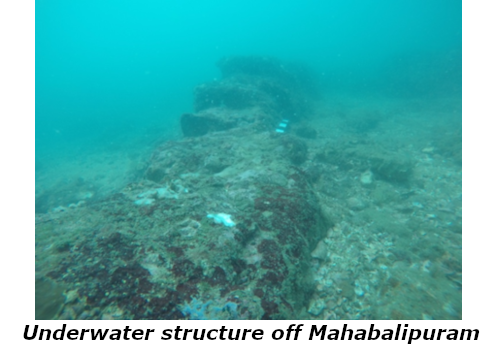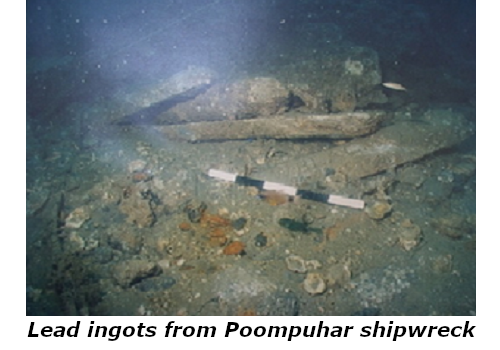Unravelling the mysteries of underwater cultural heritage
Unravelling the mysteries of underwater cultural heritage
 AThe ocean has been referred to as Ratnakara, “the bestower of wealth” in ancient Indian literature. A famous Indian mythology Samudramanthan ‘churning of the ocean’, perhaps echoes the concept of scanning of seabed for obtaining pearls, gems and seaweeds for medical value. Similarly, the destruction of coastal towns by the sea such as Dwarka on the west coast and Poompuhar on the east coast of India, have been frequently referred to in ancient literature. The legends are woven around these phenomena observed and passed on from generation to generation. India played a major role in the Indian Ocean trade and its contribution to the ship-building technique from 2500 BC to 1700 BC. With its unique winds and currents pattern, the Arabian Sea basin of the Indian Ocean has shaped the sailing and navigation techniques in this region. The trade network of the 3rd millennium BC that flourished between the Harappan region, the Persian Gulf and Mesopotamia was oceanic by its nature and included the Oman Peninsula and Bahrain
AThe ocean has been referred to as Ratnakara, “the bestower of wealth” in ancient Indian literature. A famous Indian mythology Samudramanthan ‘churning of the ocean’, perhaps echoes the concept of scanning of seabed for obtaining pearls, gems and seaweeds for medical value. Similarly, the destruction of coastal towns by the sea such as Dwarka on the west coast and Poompuhar on the east coast of India, have been frequently referred to in ancient literature. The legends are woven around these phenomena observed and passed on from generation to generation. India played a major role in the Indian Ocean trade and its contribution to the ship-building technique from 2500 BC to 1700 BC. With its unique winds and currents pattern, the Arabian Sea basin of the Indian Ocean has shaped the sailing and navigation techniques in this region. The trade network of the 3rd millennium BC that flourished between the Harappan region, the Persian Gulf and Mesopotamia was oceanic by its nature and included the Oman Peninsula and Bahrain
 The study of the maritime history of India commenced in the first decade of the 20th century that was largely based on literary data particularly, Vedas, Epics, Puranas and other contemporary Sanskrit, Pali and Prakrit literature. In the middle of the last century, the large-scale excavations of several Harappan sites in India and Bronze Age sites in the Gulf countries revealed pieces of evidence of active maritime interaction between these two geographical entities. There are numerous literary references, sculptural and archaeological evidence indicating active maritime traditions during the historical period all along the Indian coast. However, a Centre for Marine Archaeology was established in 1981 at the CSIR-National Institute of Oceanography, Goa, which started underwater explorations at a few potential sites along the Indian coast.
The study of the maritime history of India commenced in the first decade of the 20th century that was largely based on literary data particularly, Vedas, Epics, Puranas and other contemporary Sanskrit, Pali and Prakrit literature. In the middle of the last century, the large-scale excavations of several Harappan sites in India and Bronze Age sites in the Gulf countries revealed pieces of evidence of active maritime interaction between these two geographical entities. There are numerous literary references, sculptural and archaeological evidence indicating active maritime traditions during the historical period all along the Indian coast. However, a Centre for Marine Archaeology was established in 1981 at the CSIR-National Institute of Oceanography, Goa, which started underwater explorations at a few potential sites along the Indian coast.
Marine archaeological researches during the last two and half decades have brought out several potential sites along the Indian coast, which include ancient ports, jetties, and shipwrecks. The extensive explorations of the Saurashtra coast revealed several ancient ports and jetties. Interestingly, archaeological discoveries suggest that natural phenomena like tidal variations have been very effectively used in the Gulf of Kachchh and the Gulf of Khambhat in the past. Due to coastline change, several sites supposed to be on the coast are now lying far hinterland, suggesting the topographical changes. The Discovery of a large copper fishhook from the context of the Bronze Age (late Harappan) suggests that Bet Dwarka Island attracted early settlers because of marine resources such as fishes and various shells. The discovery of amphorae sherds and lead anchors from Bet Dwarka suggest that Bet Dwarka Island was the focal point of international trade and commerce during the early centuries of the Christian era. Dwarka, Somnath, Miyani, and Visawada were important port town during the historical and medieval period. Ghogha in the Gulf of Khambhat was an important Indo-Arab trading point on the Saurashtra coast.
Coastal explorations of the Maharashtra coast yielded stone anchors at Dabhol, Vijaydurg and Sindhudurg, which indicate these are active port town during the medieval period. Interestingly, Dabhol has a temple dedicated to the anchor. Stone anchors continued to be found in Goa, Kerala, Lakshadweep and on the Tamil Nadu coast in the historic and medieval periods.
 Mahabalipuram, the famous centre of Pallava art and architecture, is situated about 55 km south of Chennai on the Tamil Nadu coast. The local traditions and the foreign accounts vividly refer to the submergence of six temples out of seven. Recent underwater archaeological explorations in the area have revealed many structural remains, including fallen walls, scattered dressed stone blocks, a few steps leading to a platform and many other structural remains. The structures were badly damaged and scattered owing to strong underwater currents and swells. Due to thick biological growth, engravings on the stone blocks, if any, could not be noticed. Based on their alignment and form, they are considered to be man-made in origin. Based on the archaeological evidence on land, the earliest possible date of these structures is estimated to be around 1500 years BP. The major cause of the submergence of these structures may be due to severe coastal erosion prevailing in the region.
Mahabalipuram, the famous centre of Pallava art and architecture, is situated about 55 km south of Chennai on the Tamil Nadu coast. The local traditions and the foreign accounts vividly refer to the submergence of six temples out of seven. Recent underwater archaeological explorations in the area have revealed many structural remains, including fallen walls, scattered dressed stone blocks, a few steps leading to a platform and many other structural remains. The structures were badly damaged and scattered owing to strong underwater currents and swells. Due to thick biological growth, engravings on the stone blocks, if any, could not be noticed. Based on their alignment and form, they are considered to be man-made in origin. Based on the archaeological evidence on land, the earliest possible date of these structures is estimated to be around 1500 years BP. The major cause of the submergence of these structures may be due to severe coastal erosion prevailing in the region.
Archival records suggest a large number of shipwrecks, but many have not been found. The reason for not being able to discover the wreckage has been attributed to the discharge of large quantities of sediment on both coasts of India, which could have covered the shipwrecks beneath the seabed. Further, being in a tropical region, the wood may not have been preserved well in the marine environment. However, a few shipwrecks have been explored, and detailed work is in progress. Three shipwrecks have been found from Goa waters, and two of them do not have any wood remains; however, heavy metal artefacts like cannon, granite blocks and pottery were recovered from these wrecks. The shipwrecks in Lakshadweep and Poompuhar are better preserved, and a detailed study is awaited.
Sundaresh & AS Gaur
CSIR-NIO, Goa

 Pensioners Corner
Pensioners Corner Screen Reader Access
Screen Reader Access Skip to main content
Skip to main content

























